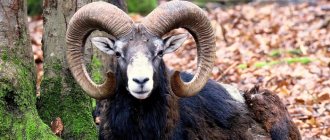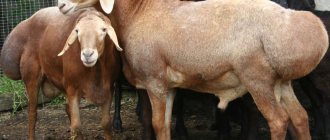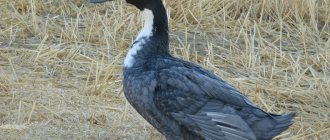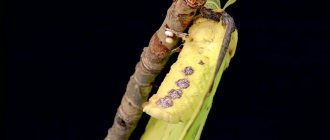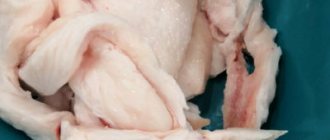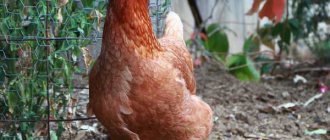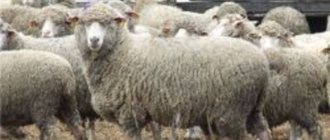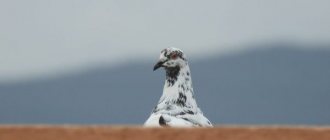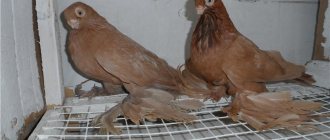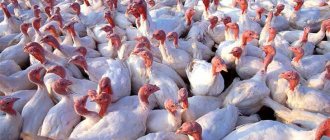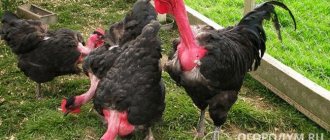Livestock » Sheep
0
6151
Article rating
Kira Stoletova
Animal fats are a controversial product, so scientists often debate their benefits and harms. Fats have long been used in the national cuisines of some peoples, but Europeans are only now beginning to get acquainted with them, and therefore the question often arises, what is the fat tail of a sheep? Why is lamb fat tail so amazing? Let's look at the strengths and weaknesses of raw materials.
Is lamb tail healthy?
How does a fat-tailed sheep differ from others?
The main difference between rams is the fat sac in the sacral region.
Thanks to the fat tail, sheep got their name. The bag contains nutrients, fat, liquid; if food and water are not available to the animal, the necessary elements will be consumed from the bag. Fat tail can be of different sizes and weights (from 5 to 20 kilograms), it depends on the diet and conditions of detention. There are several varieties of fat tail breeds.
German Merinoland sheep ('Württemberger sheep')
Breed characteristics:
- economic production of lambs throughout the year at different production intensities
- best results of feeding and carcass in the production of breeding lambs due to high food conversion
- ewes are ideal for crossing with meat breed rams to produce lambs for slaughter
- good maternal qualities, off-season hunting and breeding
- high fertility
- most suitable for keeping in pastures and paddocks
- year-round transhumance grazing, excellent adaptability to traveling long distances and being kept in a pen at night
- strong, resilient animals
- high quality merino wool
| Data, production | rams | yearling rams | uterus | yearlings | |
| meat | live weight: | 125-160 kg | 100-120 kg | 75-90 kg | 65-70 kg |
| farm growth: | 330g/day | ||||
| wool | wool clipping: | 6.5-7.0 kg | 7.0 kg | 4.0-5.0 kg | 4.0-4.5 kg |
| coat type: | white wool merino | ||||
| fiber diameter: | 26 – 28 microns | ||||
| breeding | Fertility of ewes/lambs raised: | 212/190 % | |||
| twins: | 73 % | ||||
| breeding: | 1.25 lambings/year (out of season) | ||||
| age - first mating: | 12 – 18 months |
This white, medium to large sized breed is characterized by a wedge-shaped, long head and a fleece coat that extends to the eye line (Schaupe). The ears are long and slightly drooping. The chest is wide and deep. The ribs are well rounded and the flanks are well developed. The sacrum is located in the back, the legs are full and regular. Skin folds are undesirable.
Fat-tailed sheep: photo and general characteristics
This type is characterized by long limbs, strong bones and an average height at the withers of about 100 cm. Most often, the animals are polled. The head is small in size, slightly elongated, and quite narrow. The profile is hook-nosed, the ears are drooping. Sheep weigh on average 65 kg, rams 15 kg more. These indicators are not the breed standard; there are also larger representatives. The tail has fur and can reach 8 vertebrae in length. The fleece is thick, hard, varied in color, can be red, brown, gray or black. The color is plain, without light inclusions.
Description
There are many breeds of fat-tailed sheep, each of which has its own physique, character, advantages and some disadvantages.
But if you compare not different fat-tailed breeds, but fat-tailed sheep with wool and meat sheep, then you can find certain external features of these animals:
- Fat-tailed sheep are always large. The height of a ram at the withers is about 110 cm, and that of a sheep is 75-90 cm.
- The weight of the animal can range from 60 kg (female) to 150 kg (males).
- The head is narrow and small with a hump on the nose.
- The ears are long and usually hang down.
- horns , but there are exceptions.
- All representatives of the species have a fat tail
- The fat-tailed ram has a tail of medium length, about 9-10 cm.
- The coat is thick, but always coarse, hard and short, there is no fluff.
- Color depends on the breed. Most often there are red ones, less often – brown, dark brown, black, gray, white individuals.
Varieties of fat-tailed sheep
Several new breeds were bred from the ancient fat-tailed sheep, which inherited the best qualities of their ancestors and their distinctive features. Popular varieties include Gissar, Kalmyk and Edilbaev sheep.
Edilbaevskaya breed
Animals have a strong article. Females gain weight of about 59 kg, rams - twice as much. If sheep are properly cared for, the weight may exceed the breed standard. Most often you can find black or red representatives. Black sheep grow large tails and have the best wool characteristics. The cut fleece is about 3 kg per head. Young animals produce tender meat. During the lactation period, the uterus produces milk with a high fat content, over 110 liters in 365 days. It is used for the production of cheese products and butter production.
Sheep are well kept in pasture conditions, can be grazed in any weather conditions, and have good immunity. They are most widespread in Kazakhstan, Bashkortostan, and Tatarstan. You can buy a fat-tailed sheep near Orenburg and Saratov.
Kalmyk breed
For the first time, animals began to be bred in China and Mongolia. They were crossed with a local variety of sheep. The animals bred in Kalmykia are the largest in the country.
Sheep produce meat with excellent taste, lard and soft fleece. The softest fur is found in animals of white and white-black color. The most common are black and white. The average weight for the breed is 115 kg, sometimes higher. The average fleece is about 3.9 kg.
Gissar breed
The animals are mainly distributed in Tajikistan and Uzbekistan; in our country they are not very popular. Representatives are characterized by a dark red color, or brown with a red tint. On average, queens weigh 89.9 kg. Representatives of the sebaceous trend often gain weight up to 149 kg. Fleece is rough. Young animals are used to produce meat products. During the lactation period, sheep can be milked for 60 days. The rune clipped an average of 1.9 kg and this is from the best representatives.
Saradzhinskaya
This breed comes from Turkmenistan. It is believed that Saradzhin rams are one of the smallest, since their weight traditionally does not exceed 90 kilograms, and the size of the grease sac can reach 7 kilograms.
If you plan to slaughter an animal, this should be done already at the moment when the weight of the ram has reached 37 kilograms.
The unusual characteristics of the breed include its coat. The fact is that it has an original braided structure, and the white color is endowed with a special shine and glossiness. The components of wool are fluff, awns and dead hair.
Origin
Fat-tailed sheep were first mentioned in the 3rd millennium BC. All evidence of the presence of such animals was found in Asian countries, while in Europe at that time there were simply no meat-and-fat animals. Experts explain this by the poor feed resources inherent in the states of the Central Asian region.
The main feeding grounds were pastures with sparse and nutrient-poor vegetation, so animals were selected in such a way that on this poor food they could gain weight and store fat.
In addition to these factors, an important reason for the popularity of fat-tailed animals in this region was the lard they produced, which made it possible to preserve the resulting meat in hot climates. This was especially appreciated by nomadic peoples.
Since its appearance, the distribution area of the fat-tailed varieties has not increased much. This is explained by the specificity of such sheep breeds and the differences in cultures and mentalities of different regions of the world.
Meat-fat types of sheep were and are reluctantly bred both in Russia and in other European countries. This is due to the low fertility of such animals and differences in the gastronomic tastes of the populations of Europe and Asia.
Now experts are making attempts to increase the number of tallow animals, but so far they have not achieved much success.
As it turned out, fat-tailed breeds are poorly suited for intensive methods of modern farming and many modern technologies are not applicable to them.
Breeding Features
Breeding fat-tailed sheep can become quite a profitable business. However, before you start organizing your own business and purchasing animals, you should familiarize yourself with the features and rules of their breeding.
First of all, you need to understand that in order for such an activity to make sense and be profitable, you need to purchase a livestock that will consist of at least 12 animals. This is justified by the fact that 1-2 rams will not bring you enough fat, milk or wool, but at the same time they will have to be properly cared for. That is why it is believed that it is much more profitable to purchase a small herd at once.
In order to begin direct breeding, you need to wait until the fat-tailed females reach sexual maturity. This usually occurs at 5-8 months of the animal’s life. In general, the mating process can be carried out at any time, however, late autumn is considered the most favorable period.
If you plan to perform artificial insemination, it is recommended to carry it out during the same season.
Your herd of fat-tailed sheep should contain several males at the same time, who will serve as a producer. The ideal option is a situation where you have a pair of main males on your property, as well as several spare males.
The pregnancy process in fat-tailed sheep lasts about 5 months, and the birth itself occurs quite quickly - the maximum duration is 60 minutes. From 1 to 5 lambs can be born at a time, but the latter case is more an exception and rarity than the rule.
After the lamb is born, some mandatory procedures must be carried out. You immediately need to clean his nose and mouth (mucus usually accumulates in these places), and if necessary, you need to puncture the amniotic sac. After this, the baby is returned to the mother, placed next to the nipple.
Not only the mother, but also any other uterus can feed a newly born lamb. This is important if a sheep has given birth to several babies at once, but does not have the ability to provide milk for all of them.
Productivity
sheep
have very good productivity. The animal is valued for many qualities, which is why it is in great demand in hot countries.
Fat tail is the main value obtained from the animal. In countries where fat-tailed breeds have been bred for centuries, this fat sac is highly valued for many reasons.
It is used in many industries, medicine, cosmetology, and cooking. In addition to the fat tail, wool is also obtained from rams and sheep. But since it is very rough, it is unprofitable to put it into mass production (too much waste and low quality of the resulting threads).
As a rule, felt products, rugs, blankets, felt boots, carpets and similar things are made from the wool of these animals.
The fat-tailed sheep produces a lot of meat. It has a pleasant taste, soft and tender, but most importantly, it is very expensive. The texture of the meat depends on the age of the animal - the younger the better.
Gaining muscle mass occurs quickly. Already at 6 months the ram weighs approximately 60 kg.
Important! Fat-tailed sheep can be kept on pastures around the clock, so in terms of feeding they are very profitable - the main thing is to find good pasture!
Dairy sheep can provide the breeder with a lot of good milk.
The fact is that from the first days of life, young animals can eat pasture in addition to milk, so a certain amount of milk (up to 50 liters) can be collected from sheep and sold or used for processing (cottage cheese, cheese, butter, fermented milk products).
Another method of earning money when breeding fat-tailed rams is mating. Not every herd has a good stud ram.
As a rule, these are the largest, healthiest and strongest individuals. They are in high demand, so you can bring together animals from different herds and make a profit from it.
Chemical composition and nutritional value of the product
Lamb lard is very high in calories. In 100 grams of fat tail there are about 900 kcal. Excessive consumption of lamb fat can be harmful to the body, but the benefits of nutrients in which it is very rich explain the use of fat tail fat in cooking and folk medicine. Among them the most valuable are:
- natural lanolin;
- macronutrients such as sodium, selenium, copper, phosphorus, magnesium and zinc;
- esters of saturated and unsaturated fatty acids;
- beta-carotene;
- vitamins A, B, E, D, H, PP;
- cholesterol.
Percentage yield of meat from a sheep carcass
The live weight of an adult lamb differs significantly from the weight that you will see after slaughter. In general, a lamb carcass is divided into:
- cut;
- neck;
- knuckle;
- brisket;
- flank;
- drumsticks;
- back;
- dorsal-scapular part.
After slaughter, a lamb carcass goes through many more procedures: bleeding, separation of the skin, and then the legs and head, and gutting. After all this, she loses about 50% of the slaughter yield. And these losses are considered just the beginning. Next, the bones, which make up approximately 30% of the weight, are removed, and some also get rid of cartilage and tendons. If you calculate all possible losses, then the net muscle mass will ultimately be about 70%. It follows that if a living sheep weighed 100 kilograms, then after slaughter and cleansing of all excess we will get only 30-35 kilograms of meat.
General benefits of fat tail fat
It's not just Central Asians who benefit from the beneficial properties of sheep turtles.
For many years, representatives of different nations have used this fat in traditional medicine recipes to treat many diseases, especially colds. Pork fat is also used for this purpose. Fat tail fat is also successfully used to treat respiratory diseases such as tracheitis, bronchitis and pneumonia. This is due to the fact that the substance facilitates the removal of sticky mucus and immediately has an anti-inflammatory effect. Disorders of fat metabolism and fatty liver are also a signal for internal treatment with sheep fat.
Due to its priceless taste, lamb fat is used in the culinary, medical and cosmetic industries. Let's take a look at what makes this product so useful.
For men
Fat tail fat also has a beneficial effect on the male body. A small amount of the substance added to the daily diet normalizes cholesterol levels and increases potency. In addition, it normalizes intestinal function.
If a man is involved in sports that require a lot of energy, it is also recommended to use high-calorie fat tail fat to replenish his strength. It is necessary to include a small piece of product in your daily diet that will help you adapt to physical activity and replenish your strength.
In addition, daily consumption of the product will improve memory and help you concentrate. It is equally important that lamb improves blood circulation in the brain.
To eliminate vision problems and improve immunity, it is also useful to use the product. This is due to the fact that the presence of vitamin A maintains the balance of proteins and fats at a natural level, and the presence of beta-carotene allows the product to be completely absorbed, unlike other synthetic type analogues.
For women
Fat tail fat is effective for the fair sex, as it has a beneficial effect on hormonal levels, restores and establishes the synthesis of hormones important for the female body, and increases the ability to conceive. In addition, it is recommended to use the product during menopause. This is due to the fact that lamb, thanks to the large number of active biological ingredients in its composition, is considered a source of vitality and energy, which is used by the body to generate heat and thermoregulation, supporting all necessary processes.
Lamb can also provide processes such as the formation and development of the structure of cell membranes, as well as their strengthening and protection from destruction and damage. Thanks to the antioxidant effect, the process of neutralizing free radicals occurs, which have a harmful effect on the body, accelerating the processes of tissue withering and oxidation, provoking cellular mutations. Thus, fat tail fat is an excellent anti-aging agent, as well as a way to prevent cancer.
During pregnancy
It is also beneficial to use small amounts of lamb during pregnancy. This will help fight your cold by minimizing the amount of medication you take.
It also has a beneficial effect on digestive processes due to its easy absorption. The product will improve immunity and prevent typical vitamin deficiency.
With a weakened nervous system, pregnant women will be protected due to the monounsaturated acids contained in the product, there will be a noticeable decrease in irritability and an increase in physical activity.
During feeding
Mothers with infants should take special care when consuming the product. Despite all the beneficial properties of the product, it can be harmful to the health and well-being of the child. As a rule, this is expressed by flatulence, colic, and stool disorders. Therefore, it is necessary to start using the product at the lowest dose while monitoring the child's response. If there are no negative signs, you can continue to introduce fat into your diet. However, if the child’s condition worsens at the slightest level, it is necessary to exclude the product from the menu.
For children
Fat tail fat is considered an easily digestible product and does not burden the digestive system, so it is often used to treat children.
It is strictly forbidden to consume fat before 9 months. But at the age of nine months, you can supplement the children's menu with this product if necessary. A negative reaction to a substance in a child may include vomiting, diarrhea, nausea, drowsiness and increased moodiness. In this case, it must be eliminated immediately.
For children, fat tail fat is most often used as a dishwashing liquid to treat respiratory diseases. Before such use, you should carefully examine the skin, which must be clean and intact, otherwise infection may enter the body.
Until the child reaches the age of one year, use such a compress only after consulting a doctor because the baby's skin is very sensitive, which can easily cause damage.
Before use, complete the following preparations:
- Prepare 100 g of fat tail fat and melt it in a water bath.
- Make a compress, which should consist of a gas bandage consisting of 4 layers, polyethylene, cotton wool and a bandage. Everything must be sterile clean.
Application of the compress consists of the following steps:
- Release the cheesecloth into the melted fat, then remove and squeeze lightly.
- Make sure the tampon is at an acceptable temperature and apply it to the part of the body that you want it to warm up.
- Place a layer of plastic on top of the gauze, followed by cotton wool.
- Secure the bandage.
It is important to remember that this heating method should not last more than 2 hours.
Children under 5 years old wash themselves. To do this, melted curdled fat is smoothly rubbed into the back and chest for 10 minutes. It is important to avoid the heart area. After 5 years he can study twice a day. The treatment method involves washing the back and chest area with melted fat. Then leave the used areas in a warm place for 3 hours.
Content
In order for your fat-tailed rams and sheep to have the opportunity to grow and develop properly, and, as a result, bring you benefit and profit, it is necessary to observe certain conditions for their maintenance.
First of all, it is necessary to take care of the presence of a large and spacious area that will serve as a pasture. This is necessary due to the fact that animals must spend the main period of time outdoors, free grazing.
It should be taken into account that forests and swamps will not be able to play the role of pasture, which is due to the high acid content in the pasture.
If animals regularly eat such food, then poisoning will inevitably occur in their body. To make grazing as convenient as possible, it is necessary to provide your herd with security and a leader.
If we talk about approximate periods, grazing is considered optimal for 200 days a year. The rest of the time (during winter) you need to take care of creating a dry shed.
Pay special attention to humidity levels and temperature conditions. If you keep fat-tailed animals (both adults and lambs) in a cold and damp room, then there is a high probability of developing colds.
To avoid various kinds of ailments, especially infectious ones, you need to regularly (2 times a year) give your animals vaccinations specifically designed for prevention.
In addition, do not forget to periodically show your sheep and rams to the veterinarian.
Another necessary activity is wool processing. Treatment is intended primarily to protect animals from parasites.
Shampoos, sprays and other preparations are used as disinfectants. Also, do not forget to worm your animals.
The diet of animals deserves special attention. In general, they are quite picky about food, however, fat-tailed animals should be fed with simple, but high-quality food.
For two hundred days a year, during which animals graze, there is no need to worry about food - sheep and rams eat pasture. Despite this, it is necessary to maintain the water balance of animals by providing them with free access to a large amount of water.
In winter, when grazing is not carried out, domestic animals need to be fed hay and grain. It is believed that the daily norm for one individual is approximately half a kilogram of grain and 2 kilograms of hay. In addition, vegetables and root vegetables should be included in the diet.
Harm of lamb tail and contraindications
Despite all the benefits and rich composition, lamb fat can be harmful to people prone to excess weight and suffering from certain diseases. It is not recommended to include it in the diet for pathologies of the cardiovascular system and atherosclerosis. You can use lard with caution if you have gastritis, colitis, gastric or duodenal ulcers. Susceptible individuals may develop skin allergies.
Lula kebab
- Time: 40 minutes.
- Number of servings: 4 persons.
- Calorie content of the dish: 299 kcal per 100 grams.
- Purpose: for lunch, dinner.
- Cuisine: oriental.
- Difficulty: easy.
Long-livers of the East claim that the guarantee of their health and well-being lies in special food products, among which is fat tail. Lula kebab is a national dish in the Caucasus, Central Asia, and Turkey. One of the ingredients is lamb fat, which gives the whole dish a special taste and aroma. Zira and coriander are spices that go perfectly with lamb pulp; you can adjust their quantity at your discretion.
Ingredients:
- lamb pulp - 500 g;
- fat tail - 150 g;
- coriander - 20 g;
- zira - 20 g;
- salt - 5 g;
- onions - 2 pcs.;
- ground black pepper - 2 g.
Cooking method:
- Traditionally, lamb with fat tail is chopped into minced meat with a sharp knife, but this is a very long and painstaking work that only real professionals in this matter can do. To speed up the cooking process, you can use a meat grinder or blender.
- Add spices to the minced meat and “beat” it with your hands for some time so that it is saturated with air and enriched with the aroma of spices.
- The mixture must be tested for strength so that it does not collapse during frying. To do this, you need to roll one sausage and place it on a skewer. If the minced meat holds well, then you can start frying, otherwise you need to knead it further or add one chicken egg.
- Wet your hands with water, form a meat patty weighing approximately 150 grams and distribute evenly on a skewer.
- Fry lula kebab over coals until golden brown on all sides.
- Serve the dish with freshly sliced vegetables and plenty of herbs.
Lamb tail in cooking
Despite the fact that lamb fat is a specific product with an unpleasant odor, it is popular in cooking. However, such an ingredient is rarely found in European cuisine. Sometimes it is used for frying potatoes, vegetables, and added to baked goods.
Important! Since lamb tail contains cholesterol, excessive consumption of the product makes the blood thicker and can lead to the progression of heart disease.
In which countries is it popular?
Rendered lamb lard is used mainly in the national cuisines of Asia. In these countries, its popularity is due not only to its beneficial properties, but also to the inability to replace the product with something else. Lamb fat is a secret ingredient in oriental cuisine, without which traditional recipes are considered incomplete and incorrect. In Kalmykia, there is even a unique drink made from black tea with lamb fat, spices and salt. In some regions of the East, rendered lard is added to sweets, and Syrians cannot even imagine breakfast without it.
How to melt fat tail fat
Cooking steps:
- cut into cubes and mash with a blender;
- pour cold water and leave for 30 minutes so that the product is cleaned of any accidentally trapped blood particles;
- pour the mixture into a heat-resistant bowl and place in a steam bath; you can also melt it in a frying pan with a thick bottom in the oven. Fat tail melts at a temperature of 40-90 degrees;
- readiness is determined by its uniform liquid consistency and transparency.
The finished fat tail is left to cool. When the mass becomes warm, it is filtered through gauze.
How long to cook lamb tail?
Lamb tail can be used boiled. Use large pieces of lard.
Boil the fat tail in boiling salted water with the addition of garlic, bay leaf, allspice for 30 minutes. After cooking and cooling, rub the pieces with spices, garlic and keep in the cold so that the lard is better soaked.
To get a beautiful color, you can add onion peels during cooking.
Read more about how to properly cook lamb tail. watch the video
How to dry lamb tail
You can get a dried product from salted fat tail.
Cooking instructions:
- Salt the lamb fat according to the recipe described above. Take 200 g of salt.
- Keep the fat tail in the refrigerator with the lid closed for 2 days and at room temperature for 5 days, stirring occasionally and removing the resulting juice.
- Clean excess salt from lard pieces. Make holes with a knife, thread the twine, tie it in a knot.
- Hang the tail in the air, covered with gauze, away from sunlight for 5 days.
- Remove any remaining salt from the surface and cut into slices.
Dried lamb tail
Where is it used?
The sheep's tail also has practical applications. The raw material has long been used in folk medicine as an external remedy for burns and severe wounds. A thin layer of fat has antibacterial properties, stopping the proliferation of pathogenic microbes.
The melted medicine is rubbed on the chest and back, and then wrapped in film overnight. The substance does not cause allergic reactions, so it will be safe even for children. A spoonful of fat is dissolved in a glass of milk and given to drink before bed, and within 3 days there will be no trace of cough.
The presence of lanolin in the composition is used to restore youth and beauty of the skin. For small wrinkles, it is recommended to make homemade masks with the addition of a little fat tail. To maintain hormonal stability during menopause, women add the product to their daily diet.
Thanks to its regenerating properties, fat helps in the treatment of advanced varicose veins. Thin pieces are wrapped around the affected areas and secured with a bandage. Rendered sheep fat relieves joint pain, so it is often prescribed in the form of compresses. The substance restores the skin after deep wounds, burns and ulcers.
Where and why else are raw materials used? The product is a traditional component of national dishes of the peoples of the Caucasus, Central Asia and the Middle East. It is added to tea and sweets, and soap is also made from it.
What to cook from lamb tail?
There are many recipes for dishes with the addition of fat tail; the product can be salted, boiled, fried, cooked lula kebab, added instead of butter to vegetable and meat dishes, pilaf, and baked goods with meat.
Pickling
Before salting, the lard is washed and dried. You can leave it as a 1-1.5 kg piece or cut it into 3 cm thick plates.
The mixture for salting 1 kg of fat tail is prepared from:
- heads of garlic;
- 1 soup spoon of herbs;
- half a small spoon of curry;
- half a teaspoon of black pepper;
- 3 tbsp. l. salt;
- spices to taste.
When salting a piece, multiple punctures are made in it with a knife, which are filled with the mixture, and then the lard is rubbed on top.
The piece is placed in a glass container, covered and left in the refrigerator for 3-5 days. The chopped plates are rolled in spices, placed tightly in a bowl, covered, and left in the cold for 2-4 days.
Pickling
Marinated fat tail is prepared simply; for this, a piece is cut with an accordion and placed in boiling salted water.
After 30 minutes, take out the lard, cool it, coat it with salt, pepper, and garlic. After 2 hours, the product is placed in the refrigerator for a day.
Next, the fat tail is cut into small pieces and sprinkled with red pepper, after which it is ready to eat.
How to fry potatoes on a lamb tail
Ingredients:
- lamb lard - 250 g;
- potatoes - 500 g;
- onions - 60 g;
- red sweet pepper - 1 pc.;
- yellow sweet pepper - 1 pc.;
- tomatoes - 50 g;
- eggplants - 100 g;
- salt - 15 g;
- turmeric - 10 g;
- green onion - 20 g;
- dill - 20 g.
Cooking instructions:
- Cut the peeled and washed potatoes into slices, wedges or cubes. Rinse with cold water to remove starch, dry on a towel.
- Wash the eggplants, remove the stem, cut into slices.
- Process the pepper, remove the seeds, cut into slices.
- Remove the stem from the tomatoes and cut into slices.
- Strip the fat tail, remove the vertebral bone, divide into 2 halves.
- Cut the lard into oblong slices.
- Heat a deep Dutch oven. Place the fat tail, wait until it starts to melt over medium heat, fry until the fat is rendered.
- Use a slotted spoon to remove lard from the frying pan.
- Place prepared potatoes, onions, and eggplants in a frying pan and fry in rendered lard until tender.
- 5-7 minutes before the end of cooking, add red and yellow sweet peppers, tomato slices, turmeric, cover with a lid and simmer until the vegetables soften.
- If desired, add fat tail cracklings to the dish.
- Sprinkle with green onions and dill before serving.
The calorie content of the dish is 194.44 Kcal.
Lamb tail with potatoes and vegetables
How to cook lamb liver shish kebab with fat tail
Ingredients:
- lamb tail - 500 g;
- liver - 1 kg;
- zira - 7 g;
- mineral water - 100 g;
- salt - 10 g;
- freshly ground black pepper - 7 g;
- dried parsley - 10 g;
- coriander - 10 g;
- dried dill - 10 g;
- cilantro - 20 g.
Cooking instructions:
- Peel the onions from dry scales, rinse, cut into half rings.
- Clean the tail, remove the vertebral bone, cut into slices.
- Remove the film from the liver, remove the bile ducts, cut into cubes.
- Prepare a mixture of cumin, parsley, coriander, dill, salt, and ground black pepper.
- Place the liver, fat tail, spices and salt in a deep, non-oxidizing bowl, stir and leave for 10-15 minutes.
- Grease the skewers with oil. Put liver and tail fat on them, alternating them.
- Prepare a grill with hot coals. Fry the kebabs, turning occasionally for 7-10 minutes.
- Before finishing grilling, water the kebabs with mineral water from a houseplant sprayer. Sprinkle with remaining spices and salt.
- Serve on skewers or remove the liver and fat tail to a plate. Sprinkle with fresh onions and cilantro.
Important! Mineral water will make the dish more juicy.
The calorie content of the dish is 316.55 Kcal.
Smoking gives lard a smoky aroma and a specific taste. Using various recipes, you can get a product with unique flavors.
Lamb liver shashlik with fat tail
How to bake lamb tail in the oven
Ingredients:
- lamb tail - 200 g;
- medium size potatoes - 4 pcs.;
- hard cheese - 40 g;
- salt - 15 g;
- ground black pepper - 5 g;
- lemon - ½ piece;
- garlic - 3 cloves;
- Provençal herbs - 20 g.
Cooking instructions:
- Use smooth potato tubers without deep eyes. Rinse in water and dry. Cut into an accordion style. For convenience, take 2 sushi chopsticks. Place them on the table at a distance of 3 cm from each other. Place a tuber between them. Slice the potatoes into 1cm thick slices without cutting all the way through. Spread the “accordion” so that the lamb tail can be placed between the slices.
- Free the garlic from its dry shell, rinse and chop.
- Grate the cheese on a fine grater.
- Prepare lard, cut into slices. Transfer the fat tail into a non-oxidizing bowl, add salt, ground black pepper, Provençal herbs, garlic, and sprinkle with lemon juice. Leave to marinate for 30 minutes.
- Place a slice of marinated fat tail into each cut of the potato accordion. Lubricate the tubers with a thin layer of mayonnaise.
- Place the baking sheets with stuffed potatoes in a preheated oven at 180°C for 55 minutes.
- Sprinkle the dish with grated cheese and return to the oven for 5 minutes.
- Serve with dill and parsley.
The calorie content of the dish is 280 Kcal.
You can smoke lard at home, even if you don’t have a smokehouse at hand. Use liquid smoke, which will give the finished dish a smoky flavor.
Watch a video on how to deliciously bake fat tail with eggplants
Eat moderate amounts of fat and oil - WHO recommendation
You can view dietary recommendations for adults during the COVID-19 outbreak on the WHO official website. Here is an excerpt regarding fat.
- Consume unsaturated fats (such as those found in fish, avocado, nuts, olive oil, soybean, canola, sunflower and corn oils) rather than saturated fats (such as those found in fatty meats, butter, coconut oil, cream, cheese, ghee butter and lard).
- Choose white meat (such as poultry) and fish, which tend to be lower in fat, rather than red meat.
- Avoid processed meats because they are high in fat and salt.
- Where possible, choose low-fat or low-fat versions of milk and dairy products.
- Avoid industrially produced trans fats. They are often found in processed foods, fast food, snack foods, fried foods, frozen pizza, pies, cookies, margarines and spreads.
Let us remind you that we have previously refuted information that ginger, garlic or sumac help against coronavirus. For new readers, we present an excerpt from that material. In fact, WHO only mentions ginger as a shelf-stable product, which is beneficial during quarantine. The WHO recommendation states that ginger, along with onions and garlic, are good foods that are generally inexpensive, readily available and have a longer shelf life and can be used to flavor a variety of dishes.
- Telegram
Application in cosmetology and medicine
Fat-based products are used to rejuvenate, brighten the skin, and even out the tone. The product is effective in the treatment of colds, they make wraps, add 3 drops to herbal tea.
It gets rid of:
- diseases of the kidneys, liver, gall bladder;
- fights gastritis, ulcers, thrombophlebitis;
- restores potency.
Kurdyuk saturates the body with vitamins, acids, microelements, and normalizes blood sugar levels. It is part of the Dumi Dyat oil; its medicinal properties are not inferior to badger and bear fat. To use the fat, the fat tail is not salted.
Nourishing body cream
The beneficial properties of lamb fat make it possible to make excellent creams from it, popular in East Asian countries, where women know the true price of beauty. The product easily penetrates skin cells and saturates them with valuable components. As a result, melted fat tail provides an incomparable effect, nourishing, whitening and smoothing the skin and preventing age-related changes.
To prepare a Thai mask you will need:
- lamb fat – 2 tbsp. l;
- grape or apricot seed oil – 50 g;
- beeswax - 1 tbsp. l.
The ingredients are heated in a water bath, mixed and poured into a jar for further use and storage.
For strengthening and growth of hair
To improve growth and strengthen the hair structure, it is useful to make a mask based on animal fat once a week. The product envelops hairs, protecting them from mechanical and temperature damage.
Recipe:
- rendered fat - 1 tbsp. l;
- honey - 1 tbsp. l;
- olive oil – 50 g.
Lamb fat and honey are heated to room temperature and then mixed with extra virgin olive oil. The mixture is applied to clean, damp hair and covered with a plastic cap for 40-60 minutes. After the procedure, the hair must be rinsed well with soapy water. The oil has a fairly greasy consistency, so it is difficult to wash it out of your hair. On the day of applying the mask, it is better not to plan any important events and stay at home.
For cough and bronchitis
Lamb fat is used as a cough medicine for children and adults. Its universal property lies in the possibility of its use not only internally, but also externally:
- External use. Thanks to the content of lanolin and a vitamin complex, lamb fat makes excellent ointments. When applied to the skin, the product retains heat well and increases blood circulation. The fat is rubbed on the back, feet, and chest. The patient is covered with a warm blanket and provided with rest. Treatment can be repeated until complete recovery;
- Internal use. For coughs, it is customary to drink a drink consisting of 1 teaspoon of lamb fat and a glass of boiled milk. The combination of ingredients improves the elimination of phlegm and toxins found inside the body that cause harm to it. The drink is consumed on an empty stomach. Lamb fat is also excellent for smokers to prevent lung diseases, and also as a remedy for pneumonia.
Important! Before rubbing your child with lamb fat, you should consult your doctor. In case of individual intolerance, any product made from animal fat can cause complications.
To relieve joint pain
It is useful to apply compresses to the area of concern. A thick layer of fat is applied to the problem area and wrapped in cling film for additional heating.
From heel spurs
You can get rid of heel spurs using young sheep fat, propolis and onions. The ingredients are chopped, mixed thoroughly and left for a day in a dark place. The resulting paste is applied to the affected areas before bedtime. The same remedy helps with irritations, burns, dry calluses and many other skin lesions.
From wen
Melted fat tail fat is beneficial as a remedy for tumors of skin tissue, including fatty tissues. The mass is applied to the inflammation and rubbed for 15-20 minutes. This massage is effective, and the results are noticeable within a few weeks.
For varicose veins
Compresses are also suitable for people suffering from varicose veins. To make the veins less noticeable, it is recommended to add medicinal herbs to the fat mass - colchicum, sunflower root, celandine.
Beneficial features
What are the benefits of fat tail fat:
- has a warming effect for respiratory infections, colds, relieves cough and sputum discharge during bronchitis;
- restores hormonal balance, eliminates insomnia and nervous tension that accompanies menopause;
- replenishes the body’s energy reserves after intense sports training and physical labor;
- acts as an antioxidant, smoothes and tones the skin, rendered fat helps in the treatment of dryness and frostbite;
- supports the pancreas, normalizes sugar levels in diabetes;
- thanks to the vitamins and minerals in the composition, it increases immunity and reduces the risk of colds;
- improves appearance, strengthens hair and nails;
- stimulates blood circulation in the brain, serves as a preventative against stroke, improves memory, attention and preserves vision.
Lamb fat is included in a therapeutic diet to restore strength after surgery and exhaustion. The product helps to establish lipid metabolism in case of general dystrophy and lack of fatty liver tissue. Substances contained in fat tail strengthen cell membranes and protect them from malignant degeneration. The skin and tissues of internal organs are less susceptible to free radicals and toxins, lose moisture more slowly and fade. Fat fat at the cellular level delays the aging of the body and protects against cancer. Regular consumption of lamb fat increases vital activity and strengthens the nervous system.
See also
How long to wait for lambing of a pregnant sheep and how childbirth takes place at homeRead
How to choose a fat tail when purchasing
A high-quality product is the key to a good dish: it is natural fat tail that will bring maximum benefits to the human body. To choose the right raw materials, you should consider some recommendations:
- A good fat tail has a specific but pleasant smell. Only a stale or spoiled product can smell like stale meat or ammonia;
- In order not to confuse fat tail with interior fat, you need to pay attention to its consistency. The first melts even at room temperature, resembling a thick cream, while the second is harder and less healthy, and can only be melted in a steam bath;
- The color should be milky white, with possible yellowing. Saturated gray and greenish shades indicate improper storage;
- To avoid harm typical of animal raw materials, it is better to make sure that the seller of the product has a veterinary certificate about the health status of the livestock.
Usage [ edit | edit code ]
The valuable properties of fat tail fat were noticed long ago: the most ancient images of fat tail sheep were found on dishes and in mosaics of the ancient Sumerian cities of Uruk (3,000 BC) and Ur (2,400 BC) [source not specified 1911 days
], the fat tail is also mentioned as an object of sacrifice in the Bible.
Fat tail fat
or
tail fat
does not solidify at room temperature and is used in cooking for preparing oriental dishes. Sweets and soap are also made from it. Used to make tea. Fried pieces of fat tail skin are served as a snack before meals. In addition, tail fat is used as a natural preservative for storing meat in hot climates in the absence of refrigeration equipment. Peculiar traditions of consumption and disposal of tail fat exist in Arab countries, Iran, as well as in rural regions of Transcaucasia, Central Asia and Kazakhstan.
The fat-tailed sheep has fat deposits in the tail area.
Fat tail is present only in certain breeds; the deposit in other individuals is internal lard, it is harder, harder to melt and has less nutritional value.
Interesting Facts
- The fat tail was first used 3000 BC. e. His image was found in a Sumerian mosaic. In addition, it is mentioned even in the Bible.
- Lamb fat does not have the ability to harden at room temperature, so it is often used as a natural preservative.
- When fresh, the product can be stored for 4 months in the refrigerator.
- For eastern peoples, fat tail fat is used as an effective means to increase potency and prolong life.
It is believed that all long-livers in eastern countries owe their life expectancy to fat tail fat. Whether this is true or not, no one knows for sure, but the benefits of the product have long been proven, so it is used in cosmetology, official and folk medicine, and cooking. This is a unique product that contains many useful substances.
Adviсe
- To prepare a dish or use the product as an additive, it is better to use the fat tail of a young sheep. It has a solid structure of white or slightly yellowish color, without meat inclusions, with an unobtrusive lamb smell. After melting, the fat becomes transparent, without sediment.
- To make a cough compress, lamb fat must be melted and gauze or soft cloth folded in several layers should be soaked in it. Then put the compress on the lungs or back, cover with a towel to warm up.
- Another type of compress is done for wen, when other methods have not helped. In this case, the product is applied warm to the affected area and covered with a bandage. Remove after the product has completely cooled.
- To get rid of a dry cough, you can use fat tail fat internally. To do this, add one tablespoon of the product to warm milk and let it dissolve. This combination may not appeal to everyone, but the result will not be long in coming.
Unusual story
One Moscow orientalist journalist (who told this story) was once preparing an essay about the rural residents of the Fergana Valley. Sitting with Kyrgyz women by the fire and eating delicious pilaf, she noticed that they were snacking on it with dumba plates. The crispy pieces exuded a wonderful aroma, and the journalist - a fairly young girl who uses expensive cosmetics and is significantly inferior to her older interlocutors - asked them a question:
— Tell me, in your village, do they really give babies raw dumba? “Look at us,” the women laughed. She looked. The women were like a picture - with smooth skin, sparkling mischievous eyes, moon-shaped faces, luxurious hair. - This is all dumbba - we all grew up on it! My grandmother fed us with it from the first days of our lives - so that the horsemen would love it as we grew up, because we would be famous for our beauty and health. Tell me, Muscovite, did it work? - And how! – the journalist smiled.
The women really looked great.
Step by step guide
This dish requires a deep cauldron with thick walls. Chop the lamb fat, cover the bottom of the dish with it, and place pieces of meat on top. Pepper and salt. Cut the onion into half rings and completely cover the ingredients. Don’t worry, the product will completely dissolve during the simmering process. The next layer is tomato slices sprinkled with basil.
Cover with carrot cubes and sprinkle with cumin. Cut the eggplants into thin slices (you can use zucchini) and place them in a cauldron. Place sweet pepper on top, then chopped garlic and chili. Chop the cabbage, knead with salt, and spread in a thick layer. The final link will be chopped greens.
In order for all the products to cook evenly, you need to weigh the cauldron down with something heavy, such as a baking sheet. After boiling, reduce the heat and simmer for 2.5-3 hours. At the end of cooking, remove the cabbage and boiled peppers from the cauldron - they have served their purpose. Gently mix all the ingredients and enjoy the delicious dish!
Roasting method
When rendering lamb fat, it should never be stirred. You need to cut the lard into cubes, put it in a hot cauldron and leave it over fairly high heat. After the bottom layer of lard turns into a nice, yellow-golden roast, turn the whole lump (and the pieces of lard stick together into a lump!) and let the second side reach the same color. Then remove the roast from the cauldron and use it for its intended purpose, that is, drink cold vodka with it. What is the point of this trick?
Firstly, with fussy stirring, the pieces of lard themselves fry and darken much faster, thereby changing the color of the oil in the cauldron and giving it a somewhat burnt taste.
Secondly, if the lard is not touched during rendering, it gives up much more oil: maybe up to 85% of its original weight. And after this, the frying turns out to be light on the stomach and pleasantly crunchy on the teeth. Just right for a snack.
